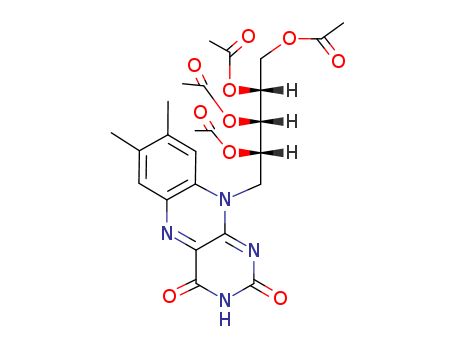- Chemical Name:Riboflavin, 2',3',4',5'-tetraacetate
- CAS No.:752-13-6
- Molecular Formula:C25H28 N4 O10
- Molecular Weight:544.518
- Hs Code.:
- European Community (EC) Number:212-032-4
- DSSTox Substance ID:DTXSID10996662
- Nikkaji Number:J3.450.976J
- ChEMBL ID:CHEMBL233068
- Mol file:752-13-6.mol
Synonyms:2,3,4,5-Tetra-O-acetyl-1-deoxy-1-(7,8-dimethyl-2,4-dioxo-3,4-dihydrobenzo[g]pteridin-10(2H)-yl)pentitol;Riboflavin, 2',3',4',5'-tetraacetate;752-13-6;[2,3,4-triacetyloxy-5-(7,8-dimethyl-2,4-dioxobenzo[g]pteridin-10-yl)pentyl] acetate;Riboflavine tetraacetate;Vitamin B2 tetraacetate;Tetra-O-acetylriboflavine;2',3',4',5'-Tetra-O-acetylriboflavin;Riboflavine, 2',3',4',5'-tetraacetate;Tetraacetylriboflavine;CHEMBL233068;DTXSID10996662;STL068827;AKOS000503328;AKOS024266897;2',3',4',5'-Tetraacetyl-lactoflavin;2,3,4,5-Tetra-O-acetyl-1-deoxy-1-(4-hydroxy-7,8-dimethyl-2-oxobenzo[g]pteridin-10(2H)-yl)pentitol;2,3,4,5-Tetra-O-acetyl-1-deoxy-1-(7,8-dimethyl-2,4-dioxo-3,4-dihydrobenzo[g]pteridin-10(2H)-yl)pentitol #





